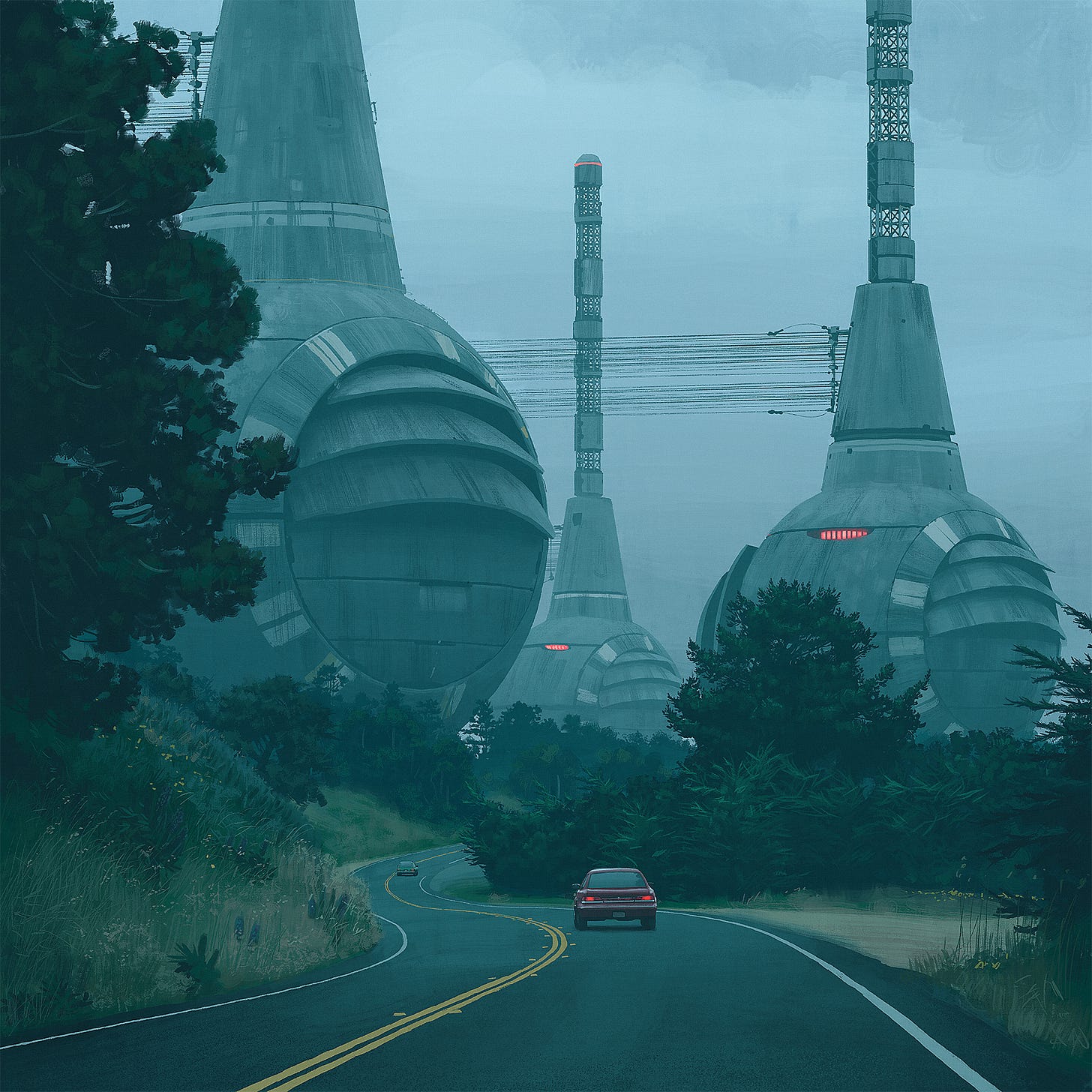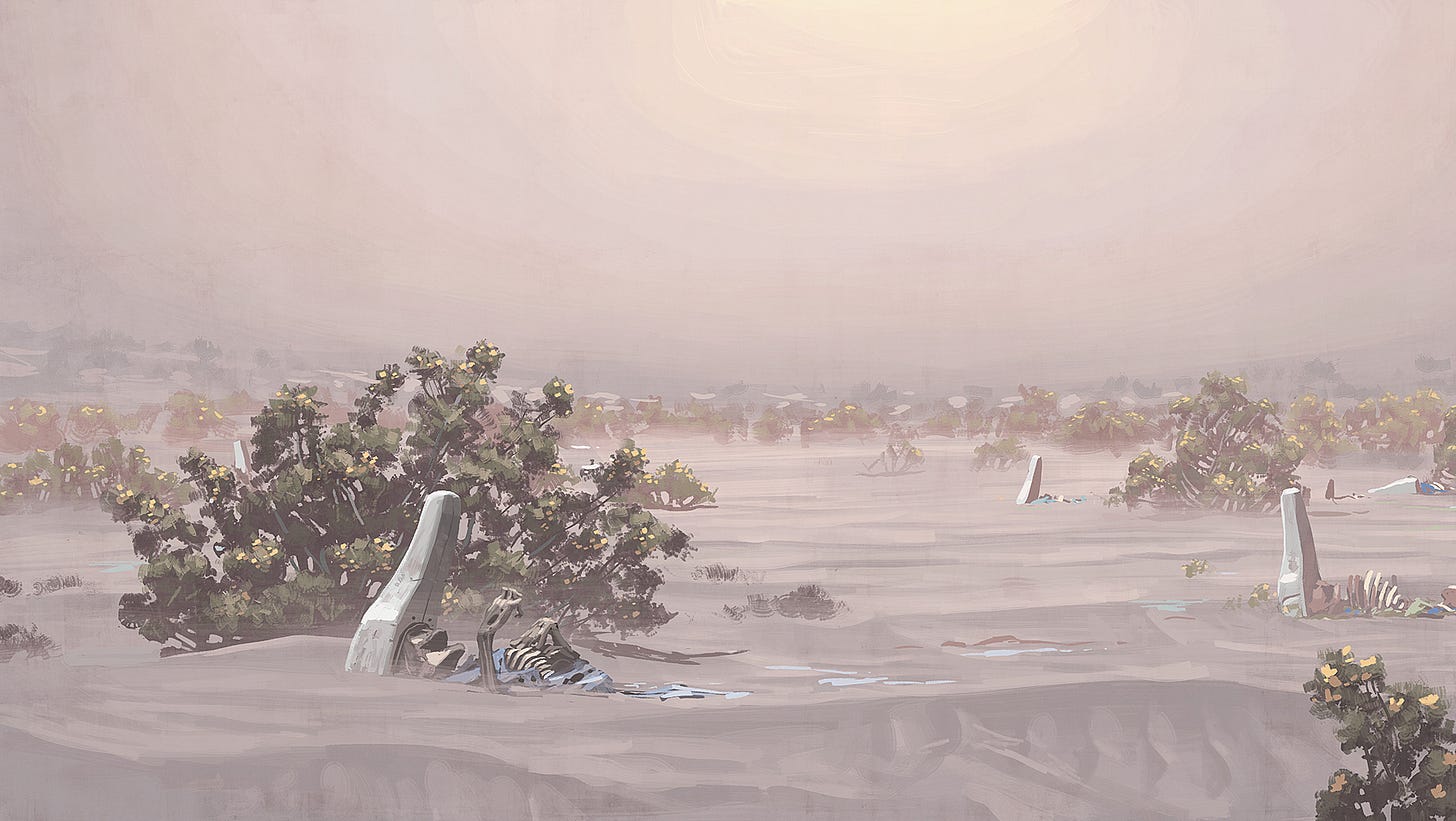I remember going through my Reddit feed when a certain post, an image, pulled me from my midnight routine of infinitely scrolling. It was an absolutely beautiful piece of art which struck me unlike anything else. I had always been interested in art of environments and landscapes and the like, and although I personally never had the mind and drive to pursue it as a serious hobby myself, I always had an appreciation for the work so many willingly shared to the rest of us untalented aesthetes.
The image had a dull, early morning blue haze that drenched the scene in a very chilled, melancholy feel. Three larger than life sci-fi-esque monolithic structures stole my attention, making the rest of the scene feel like decoration in comparison. The foreground showed a set of two cars making their way down a paved road with lush green flora on each side of them. They were driving not towards the metal giants whose transmission lines were likely humming and buzzing with energy, but past them, into that foggy future just behind those behemoth generators.
I don't recall what exact subreddit I found this image. I'm part of at least 20 different subreddits devoted to various forms of art, but I do recall searching for the artist after spending a few good quiet minutes just letting the image find a comfortable place in the most permanent parts of my memory. It was a piece by a Swedish artist named Simon Stålenhag, and I was absolutely in love. I found that it was part of a book titled "The Electric State" and immediately went to Amazon to purchase it. I didn't bother to read the book's description or reviews, the image said to me everything I needed to know. More than anything, I wanted to be in one of those cars, pursuing something beyond the fog.
The Electric State is a story surrounding a nineteen year old girl named Michelle and her robot sidekick Skip on a trek through what is the scarred and battered retro-futuristic ruins of 1997 California, now known as Pacifica, to find something lost to her. I breezed through the book in one afternoon, half due to its short script and half due to its unwillingness to let me take a break. The book sprinkles interjections from Michelle and other individuals of interest in between it's hauntingly beautiful images of a decaying west coast as she finds herself growing closer to the end of her journey. The images provide a large bulk of the story, tones and colors shifting as you progress through the story, through the world. You learn about her. You learn about the robots and the drone war and the federal army and all the strange neurograph towers. There are some things in this book that still have me reaching for answers that are just out of arms length, and all the way Stålenhag is more than happy to tease me with his visual storytelling.
His ability to craft these eerie and sometimes downright terrifying images is incredible, and it’s what I found so alluring. He possesses a unique capacity to juxtapose the strange and fictional with mundane scenes of suburbia and everyday life, and his photorealistic style of doing so was magnetic to me. Regarding the book as a whole, something was just fundamentally different about the vibrant, nostalgia filled aesthetics Stålenhag had put to page when compared to similar forms of art. While his work does include many of the themes common within the sci-fi cyberpunk genre such as transhumanism, consumerism, and the so called 'high-tech, low life' feel, there's something else he adds to the mix. In many of the other mediums in which the genre this story finds itself in is portrayed, the focus is very much on how technology, among other things, has deformed our societies. Those stories are warnings insofar that they depict worlds not too far from our own, ones in which endless consumerism and technological advancement has trumped all, including the soul. The human spirit in these alternate realities oft stand on its last legs under the pressure of an uncaring world, sold and traded for ad space on the highest neon towers in the promotion of insurmountable oppression disguised as economic and spiritual liberation.
The world Stålenhag shows us however, is one crafted by the triumph of a darker reality. It is one in which the thing lurking in the dark is not the anguished presage of a world stripped of its humanness, but rather the victory of the most wicked and malevolent parts which come with being human.
It was as if there were a code in there—a code that could, as soon as your mind detected it, irrevocably conjure demons from the depths.
In the 60s and 70s, technology is developed to allow humans to connect their consciousness to advanced robots and machines, eventually resulting in a seven year long conflict in which drone pilots far from the front engage in neuronic warfare. This neurograph technology finds its way to the civilian sector in the form of VR-esque headsets called Sentre Stimulus devices or neurocasters, slowly taking hold of the populace like a parasite might to a host. The result is horrifying. The Sentre users are described with the same language you might use describing a drug addict, and rightly so. It transforms them, seemingly letting users live their fantasies for an infinite dopamine fix. Skeletons with large obelisks on their skulls are littered throughout the book. Other Users can be found roaming in hordes and connected to large machines drifting through desolate streets, surviving purely off the neurocasters strapped to their heads. Just roaming husks.
The innate characteristics which define humanness - conflict, survival, strife, and progress, have driven this world to its breaking point, and the reader is left to see the aftermath. In Simon's world the apocalypse has already struck. Through the perspective of its protagonist, the tattered remains of the many roads, suburbs, plains, and fields are given story. The lumbering machines which dot many scenes are strikingly beautiful. Destroyed warships are scattered across hills and mountains and coasts as though they were natural structures, some showing signs of age in their scrapped remains, others proudly jutting through the rough edges of rocks showing no regard for the passage of time. Drones and scavengers alike look on in curiosity with a profound sense of danger about them.
The Electric State has left a significant impact on me and my view of "kitchen-sink sci-fi" as Stålenhag describes it, depicting a scenario in which the technology we've developed to suit our desires kidnaps us of our very being. Alien in its malformed nature, it is undoubtedly of human origin. Stålenhag gives us a window allowing us to view where the results of our most evil manifestations might lead us. And I can't stop looking.





